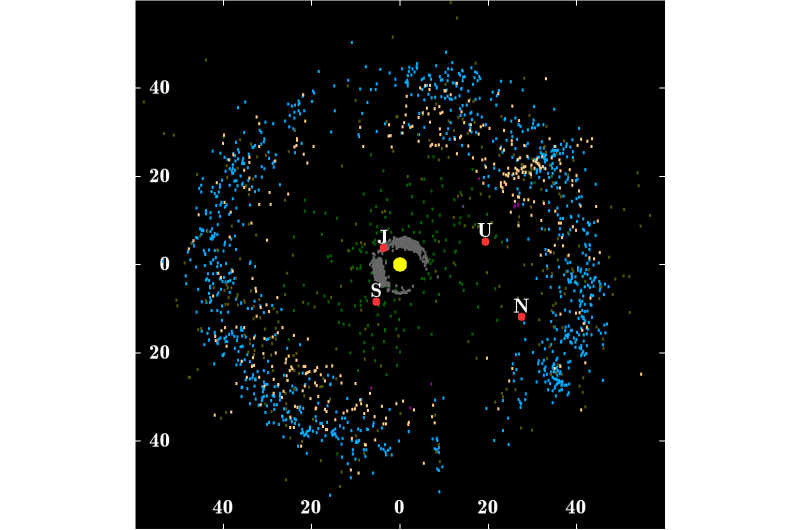August 16, 2016 report
Tagish Lake meteorite may have come from Kuiper belt

(Phys.org)—A trio of researchers is suggesting that a meteorite retrieved from the surface of a frozen lake in Canada may have come from the Kuiper belt—which if true, would be the first to be so identified. In their paper published in the Astronomical Journal, William Bottke and David Nesvorný with Southwest Research Institute in Boulder Colorado and David Vokrouhlický with Charles University in the Czech Republic outline their reasons for believing the meteorite did not come from the asteroid, but from much farther out.
In addition to eight planets, our solar system has a ring of asteroids that circle the sun between Jupiter and Mars—aptly named the asteroid belt. But out past Neptune, the most distant planet from the sun, there is another ring that circles the sun, this one called the Kuiper belt (named after Dutch astronomer Gerard Kuiper)—Pluto is just one of the objects in it. Evidence to date suggests that all of the meteorites that have been found on Earth came to us from the asteroid belt. Now, there may be an exception, as the researchers claim there is evidence to suggest the Tagish Lake meteorite (which fell in British Columbia in 2000) came from the Kupier belt.
Since it fell sixteen years ago, scientists have been looking closely at the rock, because it looked different from other meteorites. An early analysis showed that it was made mostly of carbon, but it had a higher concentration of amino acids than other meteorites—some parts as much as 100 times the usual amount.
Bottke, Nesvorný and Vokrouhlický suggest that its makeup is similar to material that has been measured in the vicinity of the larger gas giants in our solar system such as Jupiter and Saturn. They report that their simulations indicate such asteroids were once part of the Kuiper belt but were pulled inward (along with others from the Kupier belt) during a time when the big planets were jostling for position—some have even suggested that there might have once existed another gas giant in our solar system. Some of those asteroids, they note, quite likely made their way to the asteroid belt, which would have allowed them eventually to make their way to Earth.
On a related note, NASA recently approved a new mission for the New Horizon spacecraft that will bring it closer to an object in the Kuiper belt and perhaps demonstrate a close match between it and the Tagish Lake meteorite, possibly confirming the researcher's theory.
More information: David Vokrouhlický et al. CAPTURE OF TRANS-NEPTUNIAN PLANETESIMALS IN THE MAIN ASTEROID BELT, The Astronomical Journal (2016). DOI: 10.3847/0004-6256/152/2/39
Abstract
The orbital evolution of the giant planets after nebular gas was eliminated from the Solar System but before the planets reached their final configuration was driven by interactions with a vast sea of leftover planetesimals. Several variants of planetary migration with this kind of system architecture have been proposed. Here, we focus on a highly successful case, which assumes that there were once five planets in the outer Solar System in a stable configuration: Jupiter, Saturn, Uranus, Neptune, and a Neptune-like body. Beyond these planets existed a primordial disk containing thousands of Pluto-sized bodies, ~50 million D > 100 km bodies, and a multitude of smaller bodies. This system eventually went through a dynamical instability that scattered the planetesimals and allowed the planets to encounter one another. The extra Neptune-like body was ejected via a Jupiter encounter, but not before it helped to populate stable niches with disk planetesimals across the Solar System. Here, we investigate how interactions between the fifth giant planet, Jupiter, and disk planetesimals helped to capture disk planetesimals into both the asteroid belt and first-order mean-motion resonances with Jupiter. Using numerical simulations, we find that our model produces the right proportion of P- and D-type asteroids in the inner, central, and outer main belt, while also populating the Hilda and Thule regions in Jupiter's 3/2 and 4/3 resonances. Moreover, the largest observed P/D types in each sub-population are an excellent fit to our captured population results (within uncertainties). The model produces a factor of ~10 overabundance of diameter D > 10 km P/D types in the main belt, but this mismatch can likely be explained by various removal mechanisms (e.g., collision evolution over 4 Gyr, dynamical losses via Yarkovsky thermal forces over 4 Gyr, thermal destruction of the planetesimals en route to the inner solar system). Overall, our instability model provides a more satisfying match to constraints than that of Levison et al., and it provides us with strong supporting evidence that the five giant planet instability model is reasonable. Our results lead us to predict that D-type asteroids found in the near-Earth object population on low delta-V orbits with Earth are the surviving relics from the same source population that now make up the Kuiper Belt, the irregular satellites, and the Jupiter Trojans. The singular Tagish Lake meteorite, a primitive sample unlike other carbonaceous chondrite meteorites, is likely a fragment from a D-type asteroid implanted into the inner main belt. This would effectively make it the first known hand sample with the same composition as Kuiper Belt objects.
Journal information: Astronomical Journal
© 2016 Phys.org





















